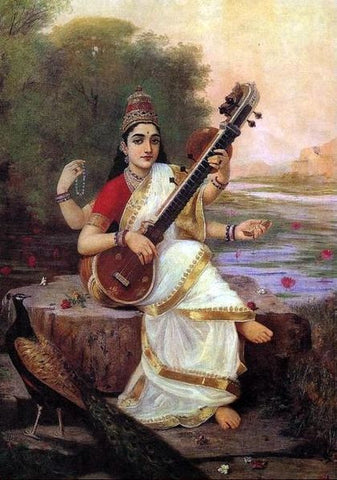Your Cart is Empty
Free Shipping for orders over $49 in Australia, $199 IN NEW ZEALAND/USA/CANADA AND $249 REST OF THE WORLD
Free Shipping for orders over $49 in Australia, $199 IN NEW ZEALAND/USA/CANADA AND $249 REST OF THE WORLD
Add description, images, menus and links to your mega menu
A column with no settings can be used as a spacer
Link to your collections, sales and even external links
Add up to five columns
Add description, images, menus and links to your mega menu
A column with no settings can be used as a spacer
Link to your collections, sales and even external links
Add up to five columns
Saraswati - Hindu Goddess of Knowledge, Music and the Arts
by Linda Heaphy May 10, 2017

A contemporary carved stone statue of Saraswati from Indonesia. Saraswati is seated on a lotus pedestal with her emblems in her hands and a peacock at her feet, symbolising her superiority over worldly desires. Photo credit: Kashgar
Saraswati is the beloved Hindu goddess of knowledge, music and the arts. In Buddhism, she is a guardian deity who upholds the teachings of Gautama Buddha. In Burma she is called Thurathadi or Tipitaka Medaw, in China her name is Biàncáitiān, in Thai, Surasawadee and in Japanese, Benzaiten.
Her name, which derives from two words, "saras" (meaning "flow") and "wati" (meaning "a woman"), gives clues as to her origin. Ten thousand years ago, a mighty river flowed, three to ten kilometers wide at its largest point. Called the Saraswati by those who lived along its banks (and now known to geologists as the Ghaggar-Hakra River), it carried glacial water from the Himalayas through the plains of northwest India and probably ended in a series of large lakes within the Thar Desert, its water only reaching the sea in very wet rainy seasons. Many significant archaeological sites have been excavated along its course-way, indicating that the river played a vital part in the development of the Indus Valley civilisation. However, the Saraswati began to dry up during the Harappan and Late Harappan phases, as evidenced by the abandonment of many settlements, disappearing completely around 1900 BCE. This probably occurred due to the capture of its tributaries by the Indus and Yamuna River systems and the loss of water in much of its catchment area, caused by deforestation, overgrazing and irrigation.
To the people who lived along her banks, the goddess Saraswati was originally a personification of the river itself. As its waters began to fail and the Harappa settlements shifted eastward towards the mighty Indus Valley, Saraswati began to lose her status as a river goddess and became increasingly associated with literature, the arts and music. As centuries passed, she grew further to embody the concepts of intelligence, consciousness, knowledge, creativity, education, enlightenment and power. This embodiment of everything associated with refinement and culture points to her importance in the founding of an independent civilisation that has endured for thousands of years.
Today Saraswati is depicted as a beautiful, light-skinned woman dressed in white, signifying the purity of true knowledge. She may be depicted near a flowing river, relating to her early history as a river goddess. Her mount is the swan, symbolising her ability to discriminate between good and bad; however she is more often pictured seated on a white Nelumbo nucifera lotus, indicating her association with Absolute Truth and with enduring purity. Occasionally she is associated with the colour yellow, the colour of the mustard plant flowers that bloom at the time of her festival in the spring. She is dressed modestly without ornaments or jewels, representing her preference for knowledge over material things. Her consort is Brahma.
Saraswati has four arms, representing the four aspects of human personality in learning: the mind, intellect, alertness, and ego. These four arms also represent the 4 Vedas (the sacred books of the Hindu faith), which in turn represent the 3 forms of literature, poetry, prose and music. She holds in her hands a book (prose), a rosary of crystal beads (poetry) and a vina (music). Her final hand holds a pot of sacred water, which represents the purity of these three arts and their power to purify human thought.

Saraswati in white, with a peacock at her feet and a river, the source of her original power, in the background. By Raja Ravi Varma (1848–1906).
1 Response
Leave a comment
Comments will be approved before showing up.
Also in Gods & Goddesses

Kali – A Most Misunderstood Goddess
by Linda Heaphy June 07, 2017
Beliefs And Customs British Raj Buddhism Demons Gods And Godesses Hinduism History India Religion Spirituality Tribal Customs
Read More
Tārā - A Beautiful Goddess For a Not So Beautiful World
by Linda Heaphy May 10, 2017
Beliefs And Customs Buddhism Gods And Godesses Hinduism India Nepal Religion Spirituality Tara Tibet
Read More Articles
About the Author
- Linda has a Honours degree in Marine Biology and a PhD in Ecology from the University of NSW, Australia. She has travelled extensively and is a passionate writer on subjects as diverse as the role played by women throughout history, tribal communities and their customs, symbology and ethnology, talismans and their history. Occasionally she also writes about her travel experiences, her new life on a 25 acres in the Northern Rivers region of northern Australia and her black miniature poodle Phoenix. She is currently writing her first book on talismans.
About Us
-
The Kashgar Philosophy

Kashgar began through a love of travel.
In 1989 my father Bernard packed in his house painting business and set off for two years on a backpacking trek to the remotest corners of the world. When he finally arrived in the oasis city of Kashgar, China, he was so impressed with its history that he decided to start a new life collecting and selling exotic goods from all over the world. For 2000 years the legendary city of Kashgar was a melting pot of ideas and a key trading post on the historic Silk Road. It was this unique combination of philosophy and trade that my father wanted to recreate at home.
Starting in markets in 1991, he opened his first store in the Sydney suburb of Newtown in 1994. I gave up my own career as a government scientist to join him in 2000 and soon convinced my partner Ian to join us in what was to become the Family Business.
Today our version of Kashgar stocks a hugely diverse range of furniture, rugs, textiles, antiques, handicrafts and jewellery sourced from over twenty different countries including India, Nepal, Tibet, China, Thailand, Burma, Laos, the Philippines, Vietnam, Mexico, Peru, Turkey, Palestine, Syria, Afghanistan and Turkmenistan. Our collection includes contemporary and tribal silver and gold jewellery, a unique range of headhunting curios, antique Buddhist relics and a collection of one-off necklaces, earrings and bracelets that I design and create myself using the beads and jewellery making techniques of ethnic minorities from around the globe.
Kashgar is a philosophy as well as a store. We are committed to supporting traditional artisans and small village communities by selling authentic handcrafted goods which are personally collected by us. By supporting traditional methods of design and production we hope to encourage local cottage industries which have a low impact on the environment and help ethnic minorities maintain their self-sufficiency into the 21st Century. We are particularly committed to assisting women around the world and to this end have worked with several organisations including the Hua Bin Women's Union of Vietnam, the East Timorese Women's Association and Tikondane in Zambia. Time honoured means of craftsmanship and traditional ways of life are disappearing as people all over the world give up their identity in favour of jeans and T-shirts. We see our trade as a means of staving off the inevitable encroachment of the 21st century, assisting communities to decide for themselves which parts of the western world they wish to incorporate (medicine, education) and which they wish to reject (prostitution, drug production, begging and servitude to warlords). We encourage our customers to think of the handicrafts and artifacts they buy from us as an investment: a piece of history and a way of life that may soon be gone forever.
Kashgar has recently closed its retail outlet and gone completely online.
In the past our pieces appeared in many movies including The Hobbit, Mission Impossible 2, Queen of the Damned, Scooby Doo, Moulin Rouge and Wolverine, and in many televisions series, as well as in plays, commercials and exhibitions. We've found special pieces for individual customers as well as for film sets, event management companies, hotels, businesses, consulates and embassies. The uniqueness of our stock means that we are also very appealing to interior and fashion designers with a taste for the exotic.
There is something for everyone at Kashgar - collectors, the curious, those looking for a special present or for something unique to adorn the home. Most of our items are one-off specialties; other pieces we only stock in small quantities so as to continuously offer a wide and ever-changing range of interesting products. We are also packed with ideas for decorating home and work premises that will challenge your established concepts of design and storage.

Please enjoy - Linda Heaphy
Become a Kashgar nomad and join our mailing list...
Sign up to get the latest on sales, new releases and more …




Poonamchand
May 30, 2023
Desh bhakti geet